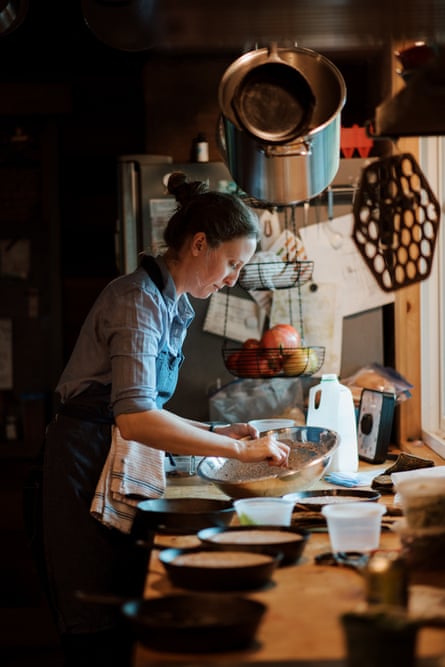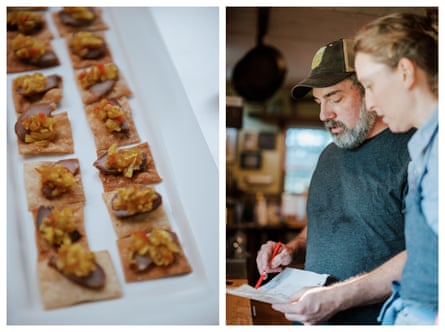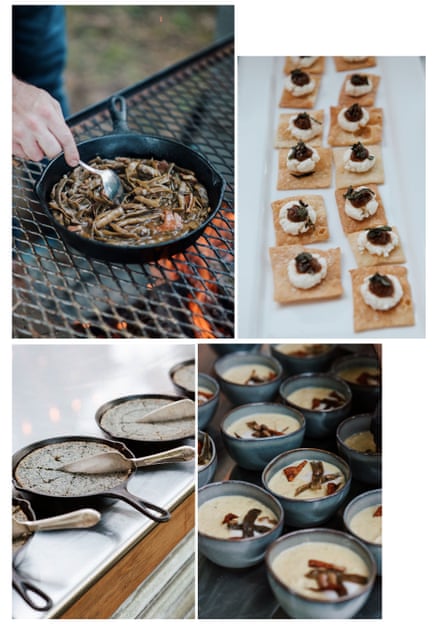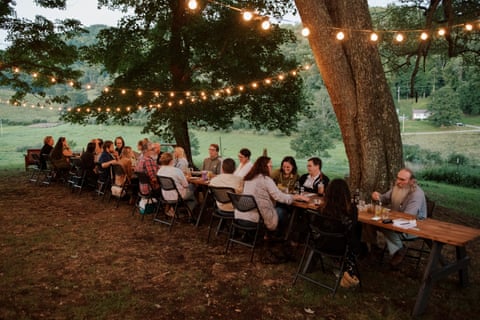Amy Dawson grew up ashamed of the family ham. It was pink and huge – close to 40lb – and sat on the kitchen counter, wrapped in newspaper throughout the winter. The ham had a hardened outside layer of dehydrated fat, which Dawson’s mom would cut into with a butcher’s knife, revealing a rich, ruby red inside. She would soak the meat she had sliced off and fry it up the next day for dinner, repeating those steps over the rest of the season.
It was delicious, but Dawson, who grew up in a farming family in West Virginia, felt humiliated when she brought friends over.

“No one else’s parents were curing meats, and the middle-class families definitely didn’t do that. It felt like something you only did because you needed to, like a poor person thing,” Dawson, who is 37, says now. Her teenage self saw success as being able to buy everything you wanted, not harvesting it yourself. She had grown up being told everything about West Virginia was backwards, and a sweating ham sitting on the kitchen counter seemed emblematic of that.
Then, on a trip to Spain in 2013, Dawson was visited by a strange deja vu. Hams were hanging from restaurant ceilings and sitting pride of place on the counters, but no one was cringing or rushing people hurriedly past, hoping they would go unseen. It was a revelation. “I asked myself: ‘Why would I feel ashamed of that ham and yet Spanish people are super proud of it?’” Dawson says.
In the UK, where I am from, having a Spanish or Italian ham shoulder or leg on your kitchen counter is now a status symbol: it communicates being cultured and well-travelled enough to know about delicacies from the European continent, having the money to buy it (they can cost upwards of $350) and, oftentimes, owning the expensive, fancy equipment to slice it.
These contradictions have always been fascinating to me, a person who grew up in an immigrant working-class family, and who now operates in a middle-class world. My family was the kind that only knew of two cheeses – “yellow” (mild cheddar) and “orange” (red leicester); we ate fish, chilli con carne and mac and cheese from the tin; and an expensive meal out for us would usually be at a fast-food chain.
As I went to university and started work as a journalist, I was soon introduced to things I’d never eaten: steak, fancy wine, cured meats. I now straddled two cultures, and food had the capacity to alienate me from both. My friends joked that I had become “bougie”, even before my material circumstances had changed.

It is a common double standard that food associated with poverty is seen as a marker of slovenliness and can bring great shame on those who eat it – until it’s adopted by the middle and upper classes. Why is it that at that point, things once derided – like tending a community garden, making your own bread, or pickling your own vegetables – become sophisticated?
“It’s when it is seen as a hobby, or a leisure activity, that someone indulges in because they want to, not because they have to – that it becomes aspirational,” Mike Costello, Amy’s husband, says.
They run a supper club together in Lost Creek, West Virginia, where they often talk about these tensions over food, and why they matter. Their food has been James Beard-nominated, their farm visited and televised by Anthony Bourdain, and they’re no strangers to rave reviews. But it is these questions about community, class and stigma – and ultimately, whether it is a bourgeois act to like good food – that pushes me to visit them.
It’s an unusually nippy evening for August in Lost Creek and I am sitting at a long, wooden table in Dawson and Costello’s backyard, looking at a baloney course – an unusual item to see on the menu of a 10-course, $110 supper club.
The chatter of the 20 or so people present is almost drowned out by a shrill chorus of crickets, but I can still hear the couple next to me. They travelled 17 hours to get here, and they are talking about the baloney.

“That’s not the kind I ate growing up!” Dan Seguin, who is from Michigan, says, chuckling to himself.
It’s certainly not your regular sandwich meat. It has the salty sweet scent of caramel, and a rich, briny, fattiness to it, but it somehow still manages to be light. It is served on a communion wafer – not the flavourless white bread usually offered up as the body of Christ, but a flaky, wafer-like biscuit.
“Once people get to a certain level of feeling like they’ve made it, they don’t eat baloney any more. They lump it in as an unhealthy food that Appalachians eat. When you use good meat, it’s actually pretty nutritious,” says Dawson.
“We want to bring it back up for people and remind them that it’s really good, and it’s OK to like it,” she says.
Made well, baloney is difficult to create: it involves cutting off the lily-white, pure fat from the back of a hog, cubing it up by hand, grinding it several times, mixing it with more meat, and seasoning it.
“One narrative lets you see baloney as a simple sandwich meat used for sustenance. Another tells the story of something really special, that dozens of hands went into making, and has thousands of stories attached to it,” Costello says.

Clarksburg, West Virginia, where Dawson grew up, was home to waves of immigration in the 1900s, who all brought their own butchery techniques to the state. Processing meat at that time was seen as gruesome, working-class labour. Xenophobia also played a part. Immigrant food, such as hotdogs (their stands manned in West Virginia by Greek immigrants), morcilla (brought by Spanish immigrants) or baloney (by Italian immigrants) – was labelled dirty and unsophisticated.
People still feel shame around those dishes, because they associate them with being poor. But Dawson and Costello want to change their associations, through the stories they tell alongside with every dish.
When Costello was five years old, he would venture out to a big, utilitarian kitchen in the basement of a local church to watch his grandmother and her friends make wafers – those same communion wafers served with the baloney. The women would beat and roll out dough in their colorful aprons, covered in splotches of flour, their arms moving slightly out of sync – almost like they were performing a Mexican wave.
“I start every supper club off with that memory, because it’s the first I have of seeing people working together as a community,” Costello says.
Alongside a corn chowder, he goes through the history of leather britches, green beans strung out and dried for storage. They can be kept for seasons, rehydrated and brought back a year later – as they have been tonight – giving them a complex, umami flavor that’s almost meat-like. A course of buttermilk poached trout comes alongside a lesson on how Appalachians salted and preserved wild trout. And for dessert, a vinegar pie – which may sound unappealing without context - tells a story of Appalachian innovation, when isolated mountain women used apple cider vinegar and nutmeg to imitate the taste of a lemon pie.

Costello believes we take in many unconscious stories about food – telling us that those who eat badly do so because they lack motivation, good taste or skill. Those stories turn poverty into an individual, rather than a societal failing, letting governments off the hook for reforming the systems that make people poor, and others rich at their expense.
Those tales are rampant everywhere, not just in the US: across the world, poverty is often depicted as a moral failing, a lifestyle choice, or a deficiency of character.
That’s why Costello is reframing stories about vinegar and nutmeg as a tale of innovation and resilience, rather than indignity. “I want to give people a sense of reverence over these traditions,” he says. “That’s harder for people to hear … Sometimes people at our dinners say, ‘I never thought I would eat this thing again, because it represents so much that I was not proud of, but now I am able to see it differently.”
Anmoore’s rolling hills are so vast that the trees that dot it look like tiny cotton balls on a worn-out sweater, and as Costello and I drive through town to get to the farmers’ market, he points out where his friend’s family farm used to be. It’s now a Walmart.
The giant corporation is West Virginia’s largest employer, paying West Virginians an hourly wage of $11.90. The state may be one of the most agriculturally rich in the country (central and southern Appalachia have the most agriculturally diverse food in all of the US, Canada and northern Mexico), but local people don’t benefit from it. Wages leave people barely enough to spend on groceries, with one in five children living in poverty.

When supermarkets were first established in the early 1900s, they were seen as vehicles for advancement, promising to bring low prices and exceptional produce from all over the world. Global produce was aggressively marketed as better quality and cheaper, and self-sustenance was subtly given the cold shoulder.
In London, where I grew up, Bangladeshi, Jewish and Afro-Caribbean communities repeatedly saw community gardens demolished in favor of “development” – often shorthand for a highway and a Tesco supermarket; and immigrants were shunned as parochial for growing their own foods. Likewise, the communal ovens of West Virginia used in the early 1900s by groups of Italian immigrants to make bread endured similar treatment: the Wonderbread which proliferated in America’s supermarkets being marketed as more nutritious.
“In America, that kind of self-sufficiency was punished,” Costello says. “The marketing for [bread] companies became: ‘Don’t let people catch you having to make your own bread at home.”
It is hard to overestimate the effect of Walmart on local economies in America. It has been accused of “destroying small-town America” by wiping out local competition and depressing wages (others argue it brings jobs, low prices and employment). Studies show that while about 53% of locally owned business revenue stays in state; 86% of Walmart’s revenues leave the state. Walmart’s domination over the retail market allows it to syphon off large parts of what farmers make, practically dictating the price it wants to buy and sell at – increasing its own slice of the pie – while farmers now commonly only keep 16 cents of every dollar spent on American produce.
This all directly relates to food poverty. When local grocery stores struggle to set up shop, and supermarkets choose not to operate in areas where they don’t believe they’ll make a profit, a gap in the market for accessible fresh food is left. As a result, food deserts appear.

These problems get dismissed as issues of motivation rather than systemic realities. In England, although children in poor areas are exposed to five times the number of fast-food restaurants as in rich areas, it is common to see politicians suggest that if working-class people simply learned to cook, or managed their money better, lines at food banks would disappear and health inequalities wouldn’t exist.
America doesn’t fare any better: in much of the country, it’s more common to see a Dollar General – with its aisles stacked with litres of soda and huge bags of chips – than it is to see fresh, filling foods at good prices, and yet public figures often claim obesity is caused by ignorance rather than low wages (just witness the millionaire owner of Whole Foods, who once said obesity is a result of poor people who prefer eating fried potatoes, ice-cream and sweets).
“It’s not just about food, it’s about being taught on every level that you should be ashamed of who you are and what you eat,” says Costello.
“A lot of people assume our goal is to prove that we’re not poor [as Appalachians]. It’s actually not. We’re trying to prove there’s nothing wrong with being poor. That you shouldn’t be shamed for the rest of your life if you are poor,” says Costello.
Dawson and Costello invite farmers and local sellers to eat at their supper clubs without a fee regularly; and try to extend the storytelling and preservation aspect of their work at different price points, by offering free YouTube recipes and Patreon lessons. But their supper club easily costs four times what a regular meal out in West Virginia costs. Do people accuse them of “bougiefying” working-class dishes and selling them on at a bumped-up price?

“Anytime you see people making a living off something that has roots in working-class survival you hear these criticisms, and it’s not always invalid,” says Costello. “But the people who have seen their family put days into making pickles or canning foods, they understand how much work it takes. If people make a living off this and aren’t adequately compensated for their labour it becomes another way of extracting from people.”
The price, they argue, could not be lower with their aims in mind – they want to raise the cash for a proper kitchen (they currently have to travel to one in town), and to build a teaching space to preserve Appalachian recipes and traditions. “Plus, the economics of scale are challenging for us. The supper club is at our house, where we can only have 20 people at a time. We’re not turning tables every hour from 5-10,” he says.
But they also want the price point to be a talking point – precisely because they believe their prices are fair.
“We are realistic. We know it’s a privilege to be able to eat at one of our supper clubs, and we would argue that what we’re doing is more of a treat than a once-a-week thing. But sometimes these criticisms come back to benefit big industry,” Costello says.
He mentions seeing a buyer at Clarksburg’s farmers’ market putting two tomatoes back after seeing they cost $6, and telling the seller she gets them a lot cheaper at Walmart.
With the major caveat that not everyone can afford to go to the farmers’ market, Costello invites more debate: “You could pay less at Walmart – but the amount of total exploitation of human beings that it took to get that tomato in Walmart grown in Mexico, shipped across the country, and sold here for only 50 cents or a dollar – is it worth it?”
Does liking good food make you bourgeois, then? I may have grown up in a working-class family, and yet I love olives, salted almonds and sourdough bread. Whatever cliche of a rich person’s eating habits you have, I delight in eating it, regardless of whether people dismiss me as a class traitor. I also still enjoy fried chicken from the cheapest, greasiest fast-food store I can find. I joyfully tuck into my mom’s spaghetti bolognese made with jar sauce, love microwaved burgers from the gas station, and devour pre-packaged sandwiches sold in the back of the corner store in London for £2.99.
These things aren’t “working-class foods” – they are the foods of my youth. They remind me of adventure, going on school trips, of loitering around after school with my friends while sharing a snack. They fill me with joy and nostalgia.

It does something ugly to the soul when you associate the things that have given you comfort in life with being vulgar, or irrelevant.
And a lot of Appalachians are proud of what they eat. Take ramps, the humble wild onion with a pungent, garlicky smell. Many of the West Virginians around Costello’s supper club table have fond memories of them.
Mindy Chua, a doctor, looks forward to ramp season in Elkins when you can smell ramps from inside your car, driving through the town in spring, ramp cook-out season. Tarry Lees Washbourne, a farmer, remembers being delivered a package of ramps while he was posted in Germany during the Vietnam war. His aunt wrapped them in socks, aluminium foil and bread sacks to try to mask their smell.
That pride did not translate into money until restaurants in New York and Washington DC put ramps on the menu, and prices shot up – with online retailers started selling them for $162 for five pounds’ worth. Even then, little of that money went into the hands of West Virginians. In many places, ramps became over-harvested, so now they can be enjoyed by fewer people.
“They became an exclusive ingredient, and we fail to interrogate what that means for the people doing the work. Ramps suddenly sell for $20 a pound in DC – and how much return are the people out wild harvesting getting? Is it worth their time and labour and the destruction to the natural ecosystem here?” says Costello.
Working-class traditions may not be valued by everyone, but some cherish them enough to pass them on. Hilary Clovis, 44, is working to preserve the old, arduous process of making salt-rising bread – an innovation that enlists potatoes instead of commercial yeast to help bread rise, born from a time when yeast was hard to come by in the Appalachian mountains.

Clovis already has cooking grease on her T-shirt when I visit her at Rising Creek Bakery in Mt Morris, Pennsylvania, on the border of West Virginia. The tiny restaurant off a main road seats about a dozen people, and Clovis’s mother’s apron has pride of place in a frame on the wall.
When Clovis was a kid, her mother became infamous for her salt-rising bread, which she would bake in batches of 18 or 20 loaves at a time for everyone she knew. People sometimes compare the smell of the bread loaves baking to stinky feet – so strong it permeates every room in the house. Without big commercial mixers, Clovis’s mother would hand-knead 40lb of dough at one time, even as she was dying of cancer, to provide comfort to the people around her.
“My grandmother had it set every Friday night when I was growing up, and on Saturday morning, we would eat the fresh bread,” Clovis says when we sit down over some slices of toast, pecan pie and a salt-rising BLT. She and her family would eat pork and salt-rising sandwiches on Sundays; or have it with butter, salt and pepper and tomatoes in the summer.
“It’s a dying breed,” says Clovis. She has rectangular glasses that slide down to the tip of her ski-slope nose when she’s making a point, giving her the impression of a friendly lecturing schoolteacher.
“I tell people, ‘If you don’t pass on this love to your kids and your grandkids, it will literally die with you’,” she says.
